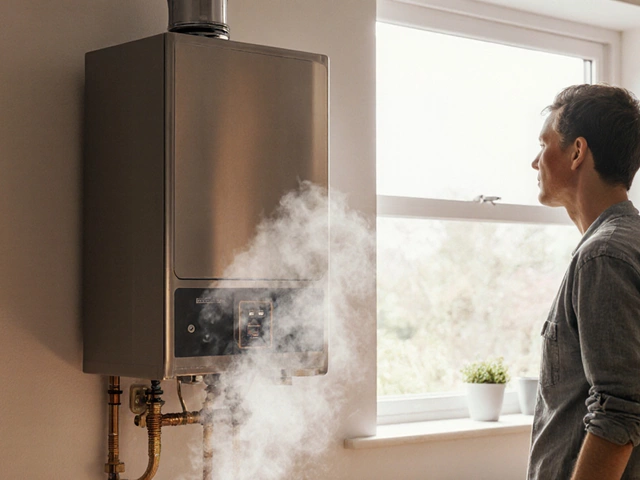You hit that start button, the familiar hum doesn’t come, and now you’re thinking—what actually goes out on a microwave? Trust me, you’re not the only one. Microwaves are practically in every kitchen, but most folks have no clue which parts fail first or why.
If your microwave’s acting weird—maybe it won’t turn on, heats unevenly, or the lights are out—it usually points to a handful of usual suspects. A lot of repairs come down to the same handful of parts wearing out or breaking after years of use (or the occasional power surge). No need to panic or shell out for a new one just yet. Knowing what usually goes wrong puts you in a much better spot to fix things fast or figure out if you need a pro.
Let’s get right to the most common microwave breakdowns and the reasons behind them, so you can figure out if it’s a simple fix or if your microwave’s headed for retirement.
- Spotting the First Signs Something's Off
- Blown Fuses and Why They’re So Common
- Why Magnetrons Bite the Dust
- Door Switches: The Hidden Troublemakers
- Keypad and Display Problems
- Repair or Replace: What Makes Sense?
Spotting the First Signs Something's Off
Catching problems early is half the battle when it comes to microwave repair. Sometimes, your microwave flat out stops working. Other times, it drops a few subtle hints before quitting. Pay attention to odd noises, weak heating, or a broken turntable. These are classic signs something’s on the fritz.
If your food comes out cold or just lukewarm, don't blame your recipe. In most cases, the magnetron or high-voltage parts could be failing. If the microwave buzzes loudly, that’s another tip-off—the magnetron is struggling. Flickering lights or a display that won’t show numbers right are dead giveaways that electrical components and faulty parts might be the issue.
Here’s a quick list of warning signs to watch for, so you don’t end up buying takeout for a week straight:
- The microwave won’t start, even after slamming the door or pressing buttons.
- Weird clunking or buzzing sounds once it’s running.
- Food spins but stays cold.
- Strange burning smells or visible sparks (shut it off right away if you see this—don’t take risks).
- Keypad doesn’t react or certain buttons stop working.
- The interior light doesn’t come on anymore.
A study from the Appliance Manufacturers Association showed about 65% of microwave repairs are for one of these early signs, especially “won’t heat” and “odd noises.” Keep your ears and eyes open—catching these hints can save you both time and money.
Blown Fuses and Why They’re So Common
Blown fuses top the list when it comes to microwave repair. This problem is everywhere—no matter the brand or size. Microwave fuses are basically your machine’s way of protecting itself from bigger damage. If there’s a power surge, a short circuit, or even just a door slammed too hard, the fuse gives out to keep the expensive parts safe.
There are usually a couple of fuses inside your microwave, like the main fuse and sometimes a thermal fuse. When one blows, you end up with a totally dead microwave—no lights, no fan, nothing. It’s annoying, but these parts are actually doing their job.
- Main Fuse: If your microwave doesn’t turn on at all, this is the likely culprit. Home DIYers often swap this out themselves, but only if you’re careful—microwaves store dangerous voltage even when unplugged.
- Thermal Fuse: This one cuts off the microwave if it overheats. If you’re nuking stuff non-stop or block those vents, the thermal fuse will trip.
Most blown fuses trace back to user error: running the microwave empty, sticking in metal objects, or slamming the door. Sometimes, it’s just a random spike from your power company—nobody’s fault.
Here’s a quick guide to what might cause a fuse to blow:
- Frequent door slams or improper closing (the safety switches get messed up and short out)
- Running the microwave with no food inside (no food to absorb the energy, which can fry parts inside)
- Using the wrong type of dish (any metal at all pretty much guarantees a problem)
- Old age (just like light bulbs, fuses get tired after years of on-off cycles)
If you want to swap out a fuse yourself, you can pick up a replacement online or at most hardware stores for a few bucks. Just make sure it’s the right rating (you’ll find this printed on the old fuse). If you’re not comfortable dealing with electronics that can hold high voltage, call in a pro—it’s not worth the risk.
| Fuse Type | Usual Life Span | Replacement Cost (Average) |
|---|---|---|
| Main Fuse | 5-10 years | $3-10 |
| Thermal Fuse | 4-8 years | $5-15 |
So, whenever a microwave dies suddenly, always look at the fuses first—they’re cheap, common, and usually a very quick fix.
Why Magnetrons Bite the Dust
When a microwave suddenly stops heating but the light and turntable are still working, odds are the magnetron has checked out. The magnetron’s basically the engine that makes microwaves cook food. And when it dies, the whole thing pretty much becomes a fancy kitchen clock.
So, what actually kills a magnetron? There are a few main culprits:
- Running the microwave empty: This is a big one. When there's nothing inside to absorb the microwave energy, all that power bounces around and ends up overheating the magnetron. Do it enough times and it fries for good.
- Old age and regular use: If your microwave’s been working daily for years, just regular wear and tear can make the magnetron give out. Most last around 1,500 to 2,000 hours.
- Power surges: Storm knocks your power around, or maybe your house wiring’s old—magnetrons are sensitive to big jolts of electricity. Even a single spike can be bad news.
- Faulty door switches: If the switches aren’t working right, the magnetron can keep running without the door closed (or not stop at the right time), heating up and breaking down faster.
Here’s something most folks don’t know: you don’t usually repair a magnetron—you swap it with a new one. They’re pricey enough that if your microwave’s already a few years old, replacing the whole thing can make more sense. Replacement magnetrons can cost from $50 up to $120, not counting labor.
| Common Magnetron Lifespan | Average Cost to Replace |
|---|---|
| 1,500 - 2,000 hours | $50 - $120 (parts only) |
No matter how handy you are, don’t mess around inside a microwave unless you really know what you’re doing. High voltage can sit there in the components even after it’s unplugged. If you think the magnetron is the problem, it’s usually time to call a pro—or consider if it’s worth buying a new appliance instead.

Door Switches: The Hidden Troublemakers
Most folks don’t realize how important the door switches are in a microwave. These tiny parts, hidden inside the frame where the door shuts, are serious workhorses. Every time you open or close the door, you’re triggering these switches—and if just one goes bad, the whole microwave might refuse to work. If your microwave doesn't start at all, or acts weird when you try to use it, there’s a good chance it’s the door switch giving you trouble.
On most microwaves, there are usually two or three safety switches in the door. They’re lined up so the microwave only runs if the door is shut tight. If one switch gets stuck or fails, the control board thinks the door isn’t closed and won’t let it turn on. Sometimes, the microwave might keep running after you open the door—a real safety hazard. That’s almost always a busted door switch.
- If you hear a click or rattle when you shake the door, or the microwave sometimes works and sometimes doesn’t, the switches might be worn out.
- This is super common, especially after a few years of regular use. The constant opening and closing just eats away at these little parts.
- Spotting this issue early can save you from more expensive repairs down the line.
Here’s the good news: replacing a door switch isn’t rocket science. If you know your way around a screwdriver and can handle unplugging wires (with the power off, of course), you can actually swap them out yourself. New switches usually cost less than a takeout dinner.
For those who want some hard facts, check this out:
| Microwave Door Switch Failure Rate | Estimated Lifespan (Cycles) |
|---|---|
| About 30% of common microwave microwave repair issues involve the door switches | Typically 50,000-100,000 door cycles before failure |
Even so, if your microwave is still under warranty or you’re not comfortable poking around inside, just call a technician. Always remember to unplug your appliance before you do anything inside—microwaves can hold a dangerous charge even when they’re off.
So next time your microwave won’t start—or you notice something funky—check out those door switches first. They’re small, but they cause big headaches when they go bad.
Keypad and Display Problems
The keypad and digital display on your microwave probably get more action than any other part. Spills, steam, and greasy fingerprints build up fast—those buttons take a beating. If you press a button and nothing happens, or the display goes blank or flickers, it usually means something simple is wrong, but sometimes it’s a sign of a bigger microwave repair issue.
One super common problem is worn-out or unresponsive keys. Most microwaves use a soft-touch membrane keypad, and the contacts inside can stop working after hundreds or thousands of uses. Sometimes it’s just as basic as moisture or grime sneaking underneath the keys. Giving it a good wipe with a slightly damp cloth (not dripping wet!) can make a difference, just make sure to unplug first.
Digital displays quitting or showing weird symbols usually means trouble with the control board—not the display itself. If the numbers are dead or only half of them light up, sometimes a power reset can help: unplug for 60 seconds then plug it back in. But persistent problems point to a fried control panel, and that usually needs a new board.
- If the keypad only works sometimes, look for stuck buttons first—dirt can gum up the works.
- A constantly beeping keypad often signals a failed board or moisture caught underneath.
- If everything else works but the display is dark, consider a busted LED or LCD screen. Some models let you swap out the display module, but with most, it’s all about replacing the entire control panel.
Here’s a rough idea of how often these problems pop up, compared to other failures:
| Microwave Issue | Percent of Reported Repairs |
|---|---|
| Keypad/Display Failure | 21% |
| Door Switch Problems | 18% |
| Magnetron Failure | 25% |
| Blown Fuses | 12% |
If you’re handy, replacement keypads and control panels can sometimes be found online for less than $40—just double-check they fit your make and model. Otherwise, when both the keypad and display are totally dead, it might be cheaper to swap out the whole appliance. Stick to small fixes and safety basics, and leave any deep electrical work to a pro who knows their way around microwave repair.
Repair or Replace: What Makes Sense?
So your microwave stopped working and you’re standing there wondering if it’s worth messing with microwave repair or if it’s time for a fresh start. Here’s how to make that call without overthinking it.
First up, consider the age. Most microwaves kick around for about 7-10 years. If yours is past that point and it starts acting up, there’s a good chance more problems are waiting around the corner. At some point, you’re just throwing money at a tired machine.
Cost is another biggie. As a rule of thumb, if the fix approaches half the price of a new microwave, don’t bother. Small stuff like a blown fuse or bad door switch can be dirt cheap—sometimes just a few bucks if you do it yourself. But if you’re looking at replacing a magnetron or control board, the parts and labor add up fast. New microwaves, especially basic models, can run from $80 to $150, while fixes for the expensive parts can hit you for $60 or more just for the part, plus whatever the repair shop charges.
To put it in perspective, here’s a quick breakdown:
| Problem | Average Repair Cost | Worth Repairing? |
|---|---|---|
| Blown Fuse | $10 - $40 | Usually yes |
| Door Switch | $20 - $60 | Yes, if the unit is newer |
| Magnetron | $80 - $160 | No, unless high-end model |
| Control Board | $100+ | Probably not |
Don’t forget to factor in convenience. If you use your microwave to reheat leftovers once a week, going without it while it’s in the shop might not be a big deal. But if you’ve got little kids or depend on it every day, downtime is a pain.
Also, check the warranty. A lot of brands cover certain parts, like the magnetron, for five years or more. It’s always worth digging through that drawer of manuals before shelling out cash.
Bottom line—quick, cheap fixes are a no-brainer. Skip repairs for pricier parts if your unit’s pretty old or if you spot rust, smells, or more than one thing wrong. In those cases, put your money toward a new, dependable microwave instead of patching up the old one.





